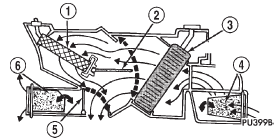Jeep Cherokee (XJ): Heater and air conditioner. Heater and air conditioner control. Heater core
DESCRIPTION All vehicles are equipped with a common heater-
A/C housing assembly (Fig. 4). The system combines
air conditioning, heating, and ventilating capabilities
in a single unit housing mounted under the instrument
panel. On heater-only systems, the evaporator
coil and recirculating air door are omitted from the
housing.
1 - HEATER CORE Outside fresh air enters the vehicle through the
cowl top opening at the base of the windshield, and
passes through a plenum chamber to the heater-A/C
system blower housing. Air flow velocity can then be
adjusted with the blower motor speed selector switch
on the heater-A/C control panel. The air intake openings
must be kept free of snow, ice, leaves, and other
obstructions for the heater-A/C system to receive a
sufficient volume of outside air.
It is also important to keep the air intake openings
clear of debris because leaf particles and other debris
that is small enough to pass through the cowl plenum
screen can accumulate within the heater-A/C
housing. The closed, warm, damp and dark environment
created within the heater-A/C housing is ideal
for the growth of certain molds, mildews and other
fungi. Any accumulation of decaying plant matter provides an additional food
source for fungal spores,
which enter the housing with the fresh air. Excess
debris, as well as objectionable odors created by
decaying plant matter and growing fungi can be discharged
into the passenger compartment during
heater-A/C system operation. OPERATION The heater and optional air conditioner are blendair
type systems. In a blend-air system, a blend-air
door controls the amount of unconditioned air (or
cooled air from the evaporator on models with air
conditioning) that is allowed to flow through, or
around, the heater core. A temperature control knob
on the heater-A/C control panel determines the discharge
air temperature by controlling an electric
motor, which moves the blend-air door. This allows
an almost immediate control of the output air temperature
of the system.
The mode control knob on the heater-only or heater-
A/C control panel is used to direct the conditioned
air to the selected system outlets. Both mode control
switches use engine vacuum to control the mode
doors, which are operated by vacuum actuator
motors.
On air conditioned vehicles, the outside air intake
can be shut off by selecting the Recirculation Mode
with the mode control knob. This will operate a vacuum
actuated recirculating air door that closes off
the outside fresh air intake and recirculates the air
that is already inside the vehicle.
The optional air conditioner for all models is
designed for the use of non-CFC, R-134a refrigerant.
The air conditioning system has an evaporator to cool
and dehumidify the incoming air prior to blending it
with the heated air. This air conditioning system
uses a fixed orifice tube in the liquid line near the
condenser outlet tube to meter refrigerant flow to the
evaporator coil. To maintain minimum evaporator
temperature and prevent evaporator freezing, a fixed
pressure setting switch on the accumulator cycles the
compressor clutch. DESCRIPTION Both the heater-only and heater-A/C systems use a
combination of mechanical, electrical, and vacuum
controls. These controls provide the vehicle operator
with a number of setting options to help control the
climate and comfort within the vehicle. Refer to the
owner's manual in the vehicle glove box for more
information on the features, use, and suggested operation
of these controls. OPERATION The heater-only or heater-A/C control panel is
located to the right of the instrument cluster on the
instrument panel. The control panel contains a rotary-
type temperature control knob, a rotary-type mode
control switch knob, and a rotary-type blower motor
speed switch knob.
The heater-only or heater-A/C control panel cannot
be repaired. If faulty or damaged, the entire unit
must be replaced. The illumination lamps are available
for service replacement. DESCRIPTION The heater core is located in the heater-A/C housing,
under the instrument panel. It is a heat
exchanger made of rows of tubes and fins. OPERATION Engine coolant is circulated through heater hoses
to the heater core at all times. As the coolant flows
through the heater core, heat removed from the
engine is transferred to the heater core fins and
tubes. Air directed through the heater core picks up
the heat from the heater core fins. The blend air door
allows control of the heater output air temperature
by controlling how much of the air flowing through
the heater-A/C housing is directed through the
heater core. The blower motor speed controls the volume
of air flowing through the heater-A/C housing.
The heater core cannot be repaired and, if faulty or
damaged, it must be replaced. Refer to Group 7 -
Cooling System for more information on the engine
cooling system, the engine coolant and the heater
hoses.Heater and air conditioner

Fig. 4 Common Blend-Air Heater-Air Conditioner System - Typical
2 - BLEND-AIR DOOR
3 - EVAPORATOR A/C ONLY
4 - RECIRCULATING AIR DOOR A/C ONLY
5 - FLOOR/PANEL DOOR
6 - FLOOR/DEFROST DOORHeater and air conditioner control
Heater core
 Dual function high pressure switch
(4.0 L). Evaporator coil. Fixed orifice tube
Dual function high pressure switch
(4.0 L). Evaporator coil. Fixed orifice tube
 High pressure cut-off switch. High pressure relief valve. Low pressure cycling clutch switch
High pressure cut-off switch. High pressure relief valve. Low pressure cycling clutch switch
Other materials:
181 FBI pinion gear depth
GENERAL INFORMATION
Ring and pinion gears are supplied as matched
sets only. The identifying numbers for the ring and
pinion gear are etched into the face of each gear (Fig.
71). A plus (+) number, minus (-) number or zero (0)
is etched into the face of the pinion gear. This number
is the am ...
